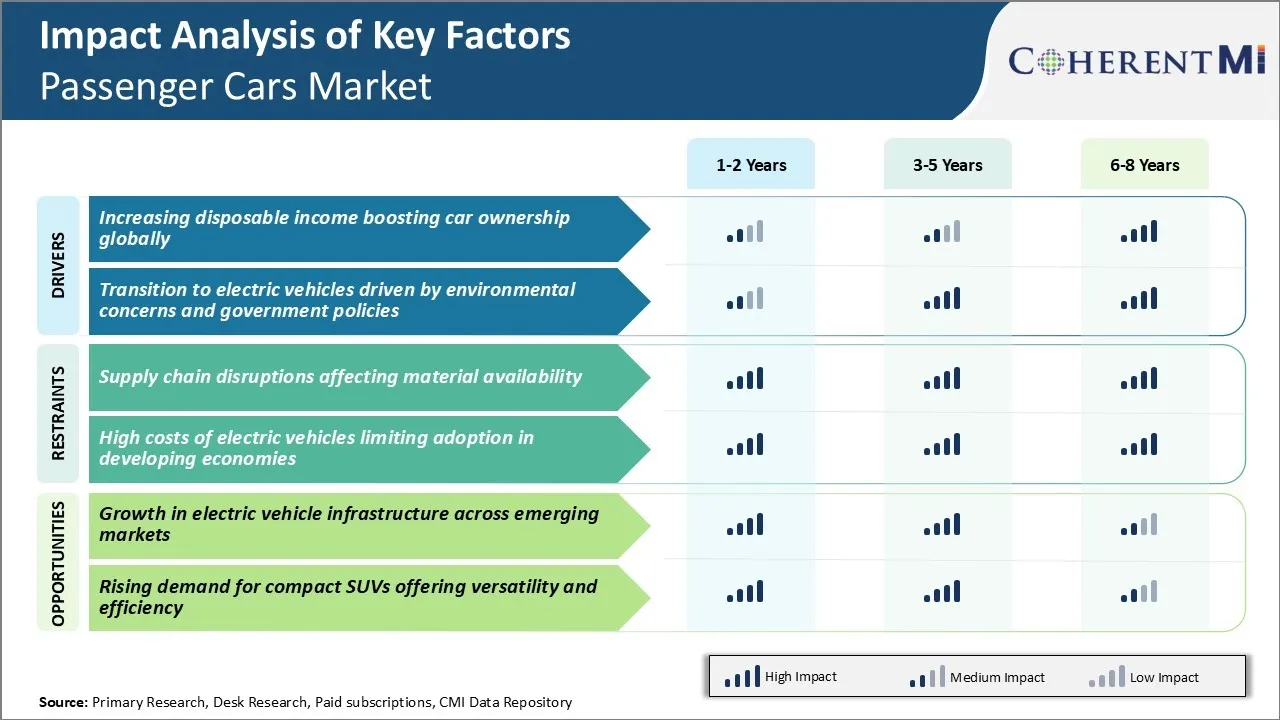Passenger Cars Market Trends
Market Driver - Increasing Disposable Income Boosting Passenger Car Ownership Globally
As economies across the world continue to improve, average disposable incomes of residents have been rising considerably. This has provided consumers with greater spending power and introduced them to modern luxuries and amenities.
As individuals make more money, their first big-ticket purchase after acquiring housing is often reported to be a passenger car. The prestige and convenience attached to owning a passenger car is rather enticing for those entering the middle and upper-middle income strata. Improved road infrastructure across urban and emerging rural territories has further bolstered connectivity and mobility. Ride-hailing services have also convinced some undecided customers about benefits of personal transportation over public modes.
Simultaneously, global automakers have launched several 'affordable' models targeted at this emerging consumer class. The success of small passenger cars especially in the above mentioned faster growing markets exemplifies the revenue opportunities arising from their rising purchasing power. Industry experts hence recognize growing affluence as a major driver propelling overall vehicle ownership upwards and expanding the addressable, passenger cars market.
Market Driver - Transition to Electric Vehicles Driven by Environmental Concerns and Government Policies
The issue of climate change has grown into one of the most pressing challenges faced by humanity. Governments worldwide have stepped up efforts to transition the sector towards cleaner alternatives. Of these, electric vehicles (EVs) are emerging as the most viable zero-emission solution, especially for personal mobility needs.
Automakers are responding with aggressive EV model launches with many aiming at 50% of their sales being battery-powered by end of this decade. Even oil exporting countries have curiously joined the switch in view of their internal pollution troubles and future-proofing economies.
Rising consumer awareness about air pollution health effects combined with lower fueling costs than petrol is boosting interest among the public as well. Regulatory tailwinds and evolving industry dynamics point towards EVs becoming massively mainstream and propelling passenger cars market volumes significantly higher than fossil fuel dependent levels. Overall, environmental protection imperatives are triggering a massive transition within the passenger cars market.

Market Challenge - Supply Chain Disruptions Affecting Material Availability
The global passenger cars market has been facing significant supply chain challenges due to the ongoing shortage of crucial materials such as semiconductor chips. As passenger car production resumed after the COVID-19 pandemic, suppliers were unable to ramp up shipments at the same pace. This led to shortage of electronic control units and other automotive-grade chips.
Original Equipment Manufacturers in the passenger cars market have been forced to repeatedly halt or curtail production lines due to non-availability of these materials. The situation does not seem to improve in the near future as it will take at least 12-18 months for semiconductor foundries and suppliers to add new capacities. This supply chain bottleneck has hampered automakers' ability to fulfil order backlogs and meet sales targets. It has also negatively impacted profit margins due to increased component prices.
Market Opportunity - Growth in Electric Vehicle Infrastructure Across Emerging Markets
One of the key opportunities for the passenger cars market is the rising focus on developing electric vehicle infrastructure across major emerging economies. Countries like China, India and Brazil have been actively working to bolster public charging networks in order to encourage consumer adoption of EVs. This includes establishing national policies around subsidy programs and setting up fast and ultra-fast charging corridors along highways.
Automakers are seizing this opportunity to accelerate their electric mobility plans in these high growth markets. Local production of affordable EVs is gathering steam with supportive regulations. Governments are also promoting use of EVs in public transportation fleets as well as ride-hailing services.
Rising concerns about urban pollution and carbon emissions are driving more emerging market consumers to consider electric options for private vehicles. With advanced lithium-ion battery technologies bringing down vehicle costs, mainstream uptake of EVs is expected to pick up significantly in developing nations over the next 5 years.